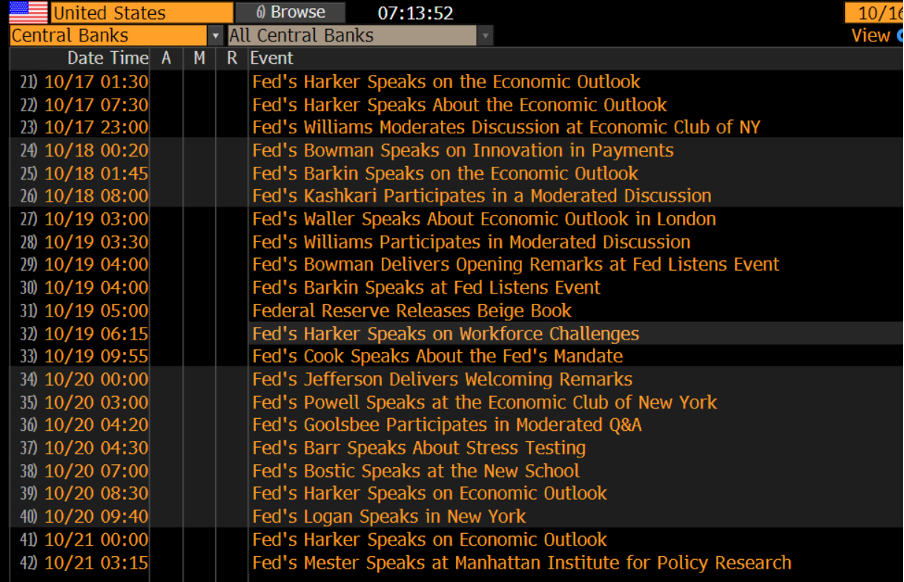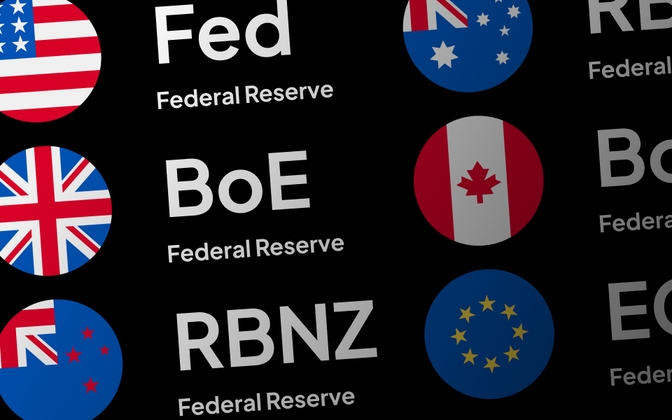Analysis
A Traders' Weekly Playbook - energy markets to direct sentiment

We saw a rush to hedge portfolios on Friday ahead of a darkening picture emerging in the Middle East. The situation is dynamic and it's too early to say if the hedges placed on Friday are unwarranted, but there have been pockets of positive news flow – for example, US Secretary of State Blinken saying aid will get to Gaza via the Egyptian border, and Israel opening water supply to Southern Gaza, with over 600k Gazans moving south.
A call between US National Security Advisor Jake Sullivan and Iranian officials is a development, with the US warning not to increase aggression. As Israel's ground offensive pushes into Gaza, risk and energy markets will look for headlines and actions from Iranian officials who have stated they have a duty to come to the aid of the Palestinians.
Watching crude and Nat Gas
The energy markets are the first derivative to drive broad market sentiment this week, with crude and Nat Gas leading investors to trade volatility (options), as well as classic hedges such as gold and Treasuries. Amid a backdrop of ‘higher for longer’, and the US CPI inflation gaining 0.4% in September, higher energy prices could deliver a one-way punch to sentiment.
Given market participants are generally poor at pricing risk around geopolitical developments, it's no wonder most have looked to mitigate drawdown - but at this stage, while there is a growing wall of worry to potentially climb, the probability is traders will use strength in risky assets to reduce exposures.
The probability of supply disruptions is one of the key aspects here – last week we saw the closure of Chevron’s Tamar gas field in Israel – the focus has been rerouting that gas from the Leviathan gas fields in the North of Israel – if the market feels this gas field could be impacted then could see a spike in EU NG. Many energy experts see the risk of a supply event here as fairly low, but should developments escalate on various fronts, then the market will increase the possibility of a disruption.

The bear case for risk, given the potential for a significant rally in EU NG and crude, would be where the market increases the probability of Iran curtailing the movement of LNG through the Straits of Hormuz, where notably Qatar LNG supply (20% of the global LNG market) would be impacted. Again, this seems a low probability at this stage, but that will depend on Iran’s ongoing involvement and any new sanctions placed on them.
Downside risk to the EUR
If EU NG spikes higher in the near term, then talk of a renewed energy crisis in Europe will resurface and the EURUSD could be headed to parity. As said, this probability is a lower risk right now, but when considering the risks, this is the market concern that will be monitored.
While sentiment will move around on each headline, we revisit the hedging flows seen on Friday, as traders de-risked ahead of potential gapping risk – It’s too hard to make a call on whether these hedges are partly unwound in Asia.
Where did we see the hedging flows?
- Gold rallied 3.4% on Friday - a 3-sigma move and the second biggest day since 2020. A massive 299k gold futures contracts traded, the highest since May. XAUUSD 1-month implied volatility has pushed to 15% and 1-week call volatility has increased to a 1.75 vol premium to puts – the most since March.
- The XAUUSD price closed at a 2.8% premium to the 5-day moving average, which shows the sheer pace of the intraday rally, with limited intraday mean reversion – sellers just stood aside.
- Brent crude closed 5% higher with our Brent price closing over $91 and eyeing a move back to the recent highs of $96 – WTI Crude futures saw the curve lift and go further into backwardation – this typically means the market sees a higher probability of a supply shock.
- In equities, the VIX traded to a high of 20.78%, settling at 19.3% (+2.6 vols on the day) – a VIX index at 19.3% implies daily % changes in the S&P500 of 1.2% and 2.7% on the week.
- S&P 1-month put implied vol now trades at a 5.46 vol premium to 1-month calls – This volatility ‘Skew’ is now the most bearish since May – traders are ramping up the demand for downside puts to protect in case of drawdown.
- Market breadth was ok with 46% of S&P500 stocks closed higher – there was no blanket selling, but a rotation from tech and consumer names into energy and defensive sectors - staples, utilities, and healthcare.
- While we saw some buying in petrocurrencies (NOK & CAD) but traders played defense buying into the CHF & JPY – short NZDCHF was the play of the day (-1.4%), with GBPCHF breaking the long-run range lows.
- US Treasuries rallied with 10’s closing -8bp and 30’s -10bp.
Marquee event risks for the week ahead:
- NZ Q3 CPI (17 Oct 08:45 AEDT) – the market consensus is for 1.9% QoQ / 5.9% YoY (from 6%) – NZDCHF was the biggest percentage mover on Friday following the risk aversion flows – will the sellers follow through?
- UK jobless claims/wage data (17 Oct 17:00 AEDT) – the consensus for wages sits at 7.8% (unchanged) – UK swaps place a 29% chance of a hike from the BoE at the 2 Nov BoE meeting, will the wage data influence that pricing? GBPCHF trades the weakest levels since Oct 2022 and looks likely to be sold on rallies
- US retail sales (17 Oct 23:30 AEDT) – the advanced read is expected at 0.3% mom and the ‘control group’ element at -0.1%. The retail numbers could influence market sentiment, especially if we see a big miss to expectations, with USDJPY and USDCHF the pairs most sensitive to a weaker outcome. Gold could find further buyers on a downside surprise.
- Canada CPI (17 Oct 23:30 AEDT) – headline CPI is expected at 4% yoy, with core CPI eyed at 4% yoy
- Fed chair Jay Powell speaks at the Economic Club of NY (20 Oct 03:00 AEDT) – the highlight of the week. Expect Powell to focus on the view that moves in the bond market are mitigating the need for the Fed to hike further.
- China Q3 GDP (18 Oct 13:00 AEDT) – consensus is 4.5% yoy (from 6.3%) – likely a trough in China’s GDP, with better levels ahead.
- China Industrial production, fixed asset investment, retail sales (18 Oct 13:00 AEDT)
- UK Sept CPI (18 Oct 17:00 AEDT) – the consensus for headline CPI is 6.6% yoy (from 6.7%) / core CPI at 6% yoy (6.2%) – a risk to manage for traders holding GBP exposures
- EU CPI (18 Oct 20:00 AEDT) – no change expected in the revision, with headline CPI eyed at 4.3% /core CPI at 4.5%. Should be a non-event for the EUR and EU equities.
- Australia employment report (19 Oct 11:30 AEDT) – the consensus estimate is for 20k jobs to have been created in September and the U/E rate unchanged at 3.7% - expect the impact from Aussie jobs to be short-lived – preference to work sell limits in AUDUSD on the day and sell into strength.
- China new homes prices (19 Oct 12:30 AEDT)
- China 1 & 5-year Prime Rate (20 Oct 12:15 AEDT) – the consensus is no change with the 1yr rate to stay at 5.2% & the 5yr rate at 3.45%
US Earnings (with the implied move on earnings) – Goldman Sachs (3.7%), Bank of America (4.6%), Tesla (5.2%), Netflix (7.5%)
Central bank speeches:
BoE – Huw Pill, Sam Woods, Swati Dhingra
ECB – Villeroy, Knot, Centeno, Guindos, Holzmann
Fed – see schedule below

Related articles
The material provided here has not been prepared in accordance with legal requirements designed to promote the independence of investment research and as such is considered to be a marketing communication. Whilst it is not subject to any prohibition on dealing ahead of the dissemination of investment research we will not seek to take any advantage before providing it to our clients.
Pepperstone doesn’t represent that the material provided here is accurate, current or complete, and therefore shouldn’t be relied upon as such. The information, whether from a third party or not, isn’t to be considered as a recommendation; or an offer to buy or sell; or the solicitation of an offer to buy or sell any security, financial product or instrument; or to participate in any particular trading strategy. It does not take into account readers’ financial situation or investment objectives. We advise any readers of this content to seek their own advice. Without the approval of Pepperstone, reproduction or redistribution of this information isn’t permitted.



